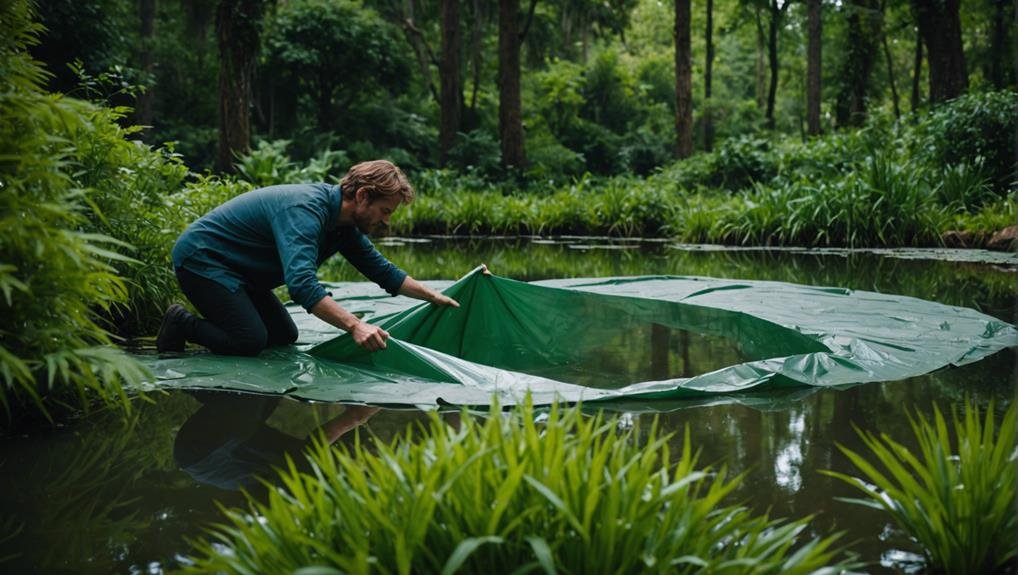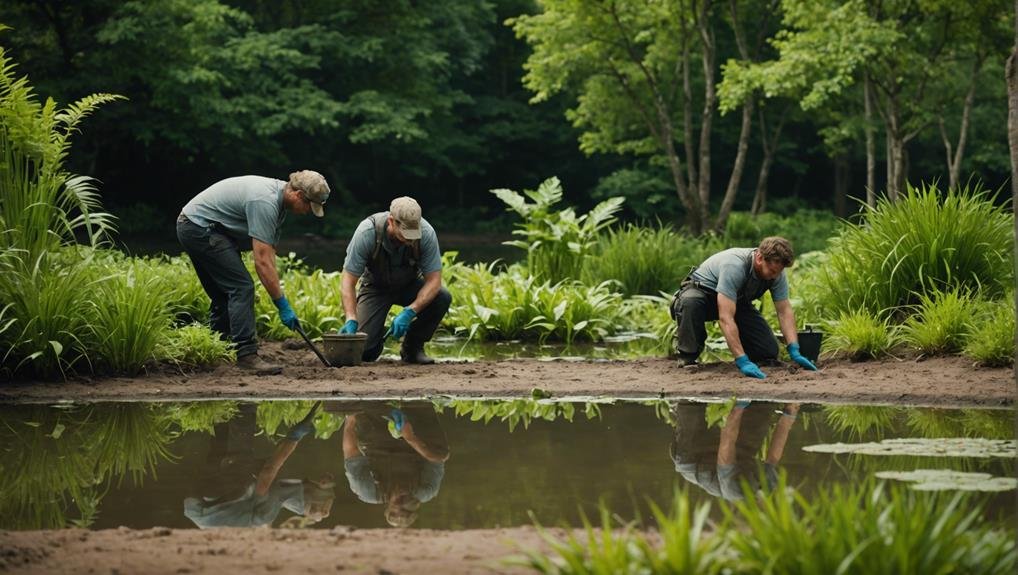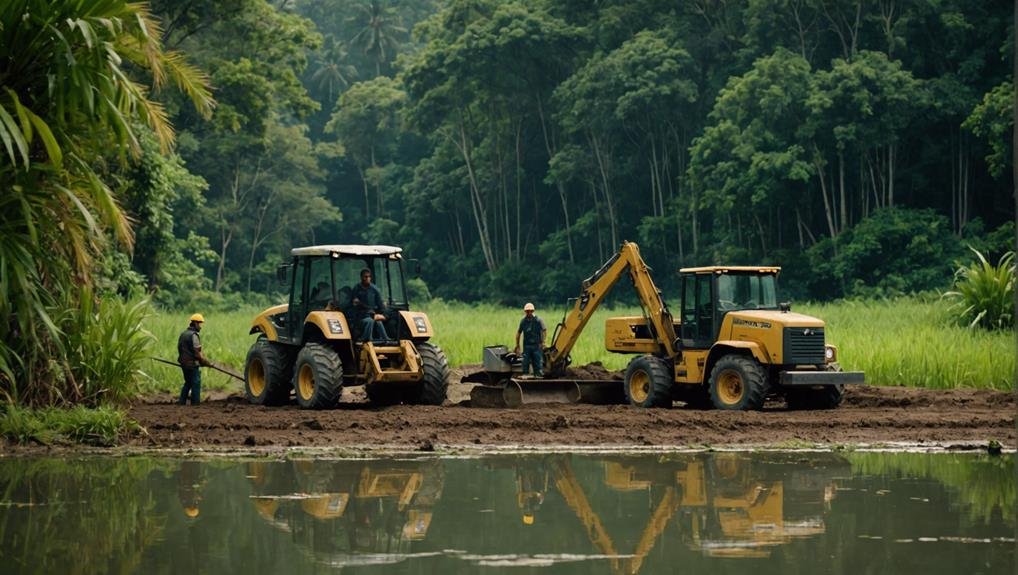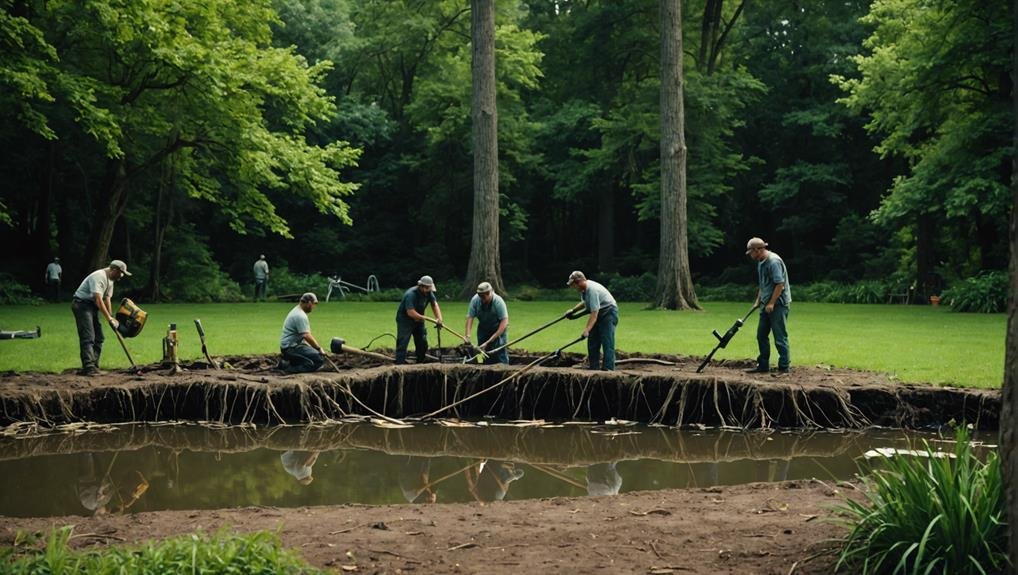Repairing pond leaks permanently involves several effective methods. One option is using bentonite clay to create a natural and durable seal.
Some of the links in this article may be affiliate links. If you make a purchase through these links, we may earn a small commission at no extra cost to you. Thank you.
Another approach is applying high-quality plastic sheeting as a cost-effective barrier.
Adding a compacted clay layer to the pond bottom offers an eco-friendly solution that lasts.
For a more advanced method, industrial plastic wraps can provide a customized fit and strong protection.
Regular soil compaction is essential for stabilizing the pond bottom and preventing future leaks.
Addressing tree root issues and innovative solutions like shredded paper or root barriers can also be beneficial.
By exploring these methods in detail, you can choose the best solution for your pond.
Identifying Pond Leaks
Identifying leaks in a pond requires a thorough inspection to pinpoint the exact source of the issue. Common causes of pond leaks include poor construction, tree roots, rusted pipes, and exposed sand or gravel at the bottom. To repair a leaking pond, it's crucial to first locate the leak.
One effective approach is to partially or completely drain the pond to expose possible leak areas. This allows for a careful examination of the liner for tears or punctures, which are typical culprits in liner leaks. Additionally, looking for damp spots around the pond's perimeter can indicate seepage. Dye tests can be utilized to track water flow and accurately identify the leak source.
It is important to monitor areas experiencing rapid water loss, as these locations often conceal significant problems. Once the leak is identified, steps can be taken to address it and prevent further damage.
Timely intervention not only conserves water but also helps maintain a thriving habitat for aquatic life. By following these steps diligently, it's possible to effectively detect and resolve a leaking pond, ensuring its long-term stability and health.
Applying Bentonite
After identifying the source of the leak in your pond, applying bentonite is an effective solution to seal it and restore the pond's integrity. Bentonite, a natural clay material known for its excellent sealing properties, is a popular choice for repairing ponds due to its ability to expand and form a tight seal when wet. This expansion creates a strong barrier that prevents water from escaping, effectively addressing the leak and maintaining water levels in the pond.
To apply bentonite, the first step is to drain the pond to expose the leaky area. Once the leak is located, a layer of bentonite clay is evenly spread over it to ensure complete coverage. After the application of bentonite, the pond is refilled with water, allowing the clay to absorb moisture and expand, sealing the leak effectively.
Using bentonite for pond repairs isn't only efficient but also cost-effective. It offers a long-lasting solution, reducing the need for frequent repairs. By incorporating bentonite in the repair process, a reliable barrier is created to help maintain water levels and prevent future leakage issues. This method is widely preferred for its simplicity and proven results in fixing pond leaks.
Using Plastic Sheeting

Plastic sheeting proves to be a cost-effective and durable solution for permanently sealing pond leaks. It creates a long-lasting barrier against water seepage, ensuring a secure seal that prevents future leaks.
The key to success lies in the careful installation process. Customizing the plastic sheeting to fit the pond's dimensions and shape is crucial to complete coverage without any gaps. Smoothly laying the sheeting and ensuring there are no wrinkles or folds that could compromise the seal is essential. Overlapping the edges of the plastic to create a tight seal around the perimeter further enhances its effectiveness.
Regular maintenance and inspection play a vital role in preserving this solution's longevity. Periodically checking the plastic sheeting allows early identification of any potential issues, enabling prompt resolution. This proactive approach is instrumental in maintaining the seal's integrity and ensuring a leak-free pond.
For optimal results, high-quality plastic sheeting is recommended for its durability and reliability in sealing leaks effectively.
Adding a Clay Layer
Adding a layer of clay to the pond bottom is a smart and eco-friendly way to fix leaks and keep water levels stable. By compacting clay onto the pond floor, a natural barrier is created to reduce seepage and strengthen the pond's structure. This approach is budget-friendly and durable, making it a perfect solution for resolving pond leaks.
To carry out this process effectively, follow these steps:
- Preparation: Start by clearing the pond bottom of any debris and plants to ensure a smooth surface for the clay layer.
- Application: Spread a thick, even layer of clay across the pond bottom, aiming for a depth of several inches.
- Compaction: Compact the clay layer thoroughly using rollers or heavy machinery to form a solid, leak-proof barrier.
Well-compacted clay can endure water pressure and environmental elements, securing the pond against leaks over time. This impermeable layer serves as a dependable method to prevent water seepage and uphold consistent water levels. By mastering these steps, you can effectively seal the pond, preserving its functionality and value in your landscape.
Alternative Solutions

When it comes to fixing pond leaks, there are several innovative and sustainable solutions to consider. One interesting method involves using pigs to naturally compact the soil and create a clay layer that can prevent water from draining out of the pond. This not only helps seal the pond but also benefits the ecosystem by controlling invasive plants and providing habitats for various organisms.
Another approach is to use materials like bentonite, Seminole mud, or industrial products such as shredded paper and leftover end rolls from printing presses. These materials can be strategically applied to create a seal layer in the pond, ensuring long-lasting repairs with minimal environmental impact.
Here is a comparison of some alternative solutions for pond leaks:
Bentonite: This material expands when wet, forming an impermeable layer that effectively seals leaks.
Shredded Paper: An eco-friendly option that helps absorb water and compact the soil, aiding in sealing the pond.
Pigs: By naturally compacting the soil, pigs contribute to maintaining a balanced ecosystem while sealing the pond.
Seminole Mud: A traditional method that remains highly effective in sealing leaks in ponds.
Industrial Plastics: These products create a durable, waterproof barrier in the pond, offering long-term protection against leaks.
Kitty Litter: Similar to bentonite, kitty litter is easily accessible and can be used to seal pond leaks effectively.
Introducing Livestock
Utilizing pigs' natural behaviors can be a creative and environmentally friendly approach to effectively fixing pond leaks. Pigs are well-suited for this task thanks to their instincts for rooting and wallowing, which can compact the pond bottoms and prevent water seepage.
By introducing pigs to the leaking pond area, we can take advantage of these behaviors to enhance the pond's watertightness.
The advantages of employing pigs for pond leak repairs are abundant. Firstly, pigs' digging and rooting activities naturally compress the clay, aiding in sealing any leaks present in the pond. Additionally, pigs can consume and trample leak-causing plants like willows, reducing the risk of future leaks.
This method isn't only effective but also sustainable and eco-friendly, as it relies on natural behaviors without the need for chemical treatments. By harnessing the unique abilities of pigs, we can address pond leaks in a practical and environmentally conscious manner.
Soil Compaction Techniques

Soil compaction techniques play a crucial role in pond construction and repair by creating a solid barrier that prevents water seepage. Compacting the soil properly reduces the risk of pond leaks and improves water retention. This process involves using heavy equipment like track hoes to compress the soil around the pond, forming a dense layer that stops water from leaking.
Alternatively, an effective and environmentally friendly method is utilizing livestock, such as pigs, to compact the soil. Pigs' natural rooting and trampling behaviors help compact the soil and seal leaks in a more natural way. This technique not only stabilizes the pond bottom but also lowers the chances of future leaks.
Compacted soil acts as a natural sealant, potentially eliminating the need for synthetic pond liners. By ensuring a well-compacted pond bottom, a more stable and durable barrier against water loss is created.
Whether using machinery or livestock, soil compaction is a critical step in achieving long-term water retention and preventing seepage in pond construction and repair.
Industrial Plastic Wraps
Industrial plastic wraps offer a practical and cost-effective solution for fixing pond leaks and preventing water loss. These wraps serve as a reliable barrier, effectively covering and sealing damaged areas or the entire pond bottom. By using industrial plastic wraps, we can efficiently address leaks and maintain the water level in our ponds.
When considering the use of plastic wraps for pond leak repairs, it's essential to consider a few key factors:
- Versatility: Industrial plastic wraps can be customized to fit various pond sizes and shapes, making them a flexible option for different pond liner needs.
- Ease of Use: These wraps are typically included in repair kits and are easy to install, allowing us to address leaks without requiring specialized skills.
- Longevity: When applied correctly, industrial plastic wraps provide a durable solution that can endure the elements and prevent future leaks effectively.
Before applying the wrap, it's important to ensure that the pond is drained, and the area to be covered is clear of debris and loose soil. This preparation helps create a smooth surface for the wrap, enhancing its efficiency.
Addressing Tree Root Impact

Tree roots pose a significant threat to pond liners, leading to leaks and water loss that require immediate attention. As tree roots grow, they can puncture the pond liners, causing small tears that result in leaks and substantial water loss over time. Since tree roots naturally seek out water sources, ponds are particularly susceptible to root damage if trees are planted nearby.
To prevent these issues, it's crucial to regularly monitor and maintain the trees and the pond area. Keeping a close watch on the root systems for any signs of encroachment towards the pond can help in early detection and prevention of damage, avoiding costly repairs and water loss.
One effective solution to address tree root impact is the installation of root barriers. These barriers act as a shield, preventing roots from reaching the pond liners and reducing the risk of leaks.
In cases where roots have already caused damage, prompt removal of the problematic trees and repairing the liner are necessary steps to prevent further leaks and damage.
Implementing strategies like installing root barriers, monitoring root encroachment, and removing damaging trees can help mitigate the impact of tree roots on pond liners, ensuring the longevity and proper functioning of the pond ecosystem.
Conclusion
Repairing pond leaks requires a thoughtful approach, similar to solving a puzzle. There are several methods to address leaks effectively. These include using bentonite, installing plastic sheeting, or adding a clay layer. Other techniques, such as introducing livestock, compacting the soil, or using industrial plastic wraps, can also be helpful. It's important to consider the impact of tree roots when addressing leaks. By combining these strategies, a durable solution can be achieved for a thriving and sustainable pond.

